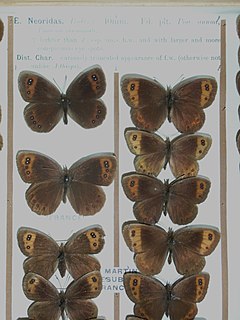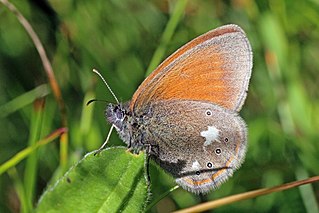
Vanessa atalanta, the red admiral or, previously, the red admirable, is a well-characterized, medium-sized butterfly with black wings, red bands, and white spots. It has a wingspan of about 2 inches (5 cm). It was first described by Carl Linnaeus in his 1758 10th edition of Systema Naturae. The red admiral is widely distributed across temperate regions of North Africa, the Americas, Europe, Asia, and the Caribbean. It resides in warmer areas, but migrates north in spring and sometimes again in autumn. Typically found in moist woodlands, the red admiral caterpillar's primary host plant is the stinging nettle ; it can also be found on the false nettle. The adult butterfly drinks from flowering plants like Buddleia and overripe fruit. Red admirals are territorial; females will only mate with males that hold territory. Males with superior flight abilities are more likely to successfully court females. It is known as an unusually calm butterfly, often allowing observation at a very close distance before flying away, also landing on and using humans as perches.

The small tortoiseshell is a colourful Eurasian butterfly in the family Nymphalidae. Adults feed on nectar and may hibernate over winter; in warmer climates they may have two broods in a season. While the dorsal surface of the wings is vividly marked, the ventral surface is drab, providing camouflage. Eggs are laid on the common nettle, on which the larvae feed.

Vanessa indica, called the Indian red admiral or the Asian admiral in the United States, is a butterfly found in the higher altitude regions of India, primarily the Himalayas and the Nilgiri Hills. It is also found in Sri Lanka and Myanmar, China, Korea, SE Russia, Japan. It is a close relative of the painted lady.

Vanessa is a genus of brush-footed butterflies in the tribe Nymphalini. It has a near-global distribution and includes conspicuous species such as the red admirals, the Kamehameha, and the painted ladies of the Cynthia group : Painted lady, American painted lady, West Coast lady, Australian painted lady, etc. For African admirals, see genus Antanartia. Recently, several members traditionally considered to be in the genus Antanartia have been determined to belong within the genus Vanessa.

The Raetzer's ringlet is a species of butterfly in the family Nymphalidae. It is found in Italy and Switzerland. Its natural habitat is temperate grassland. It is one of the rarest European butterflies, having not more than six or seven populations.

Erebia epistygne, the spring ringlet, is a species of butterfly in the family Nymphalidae. It is found in France and Spain. Its natural habitat is temperate grassland.

Erebia pharte, the blind ringlet, is a butterfly of the family Nymphalidae. It is an Alpine butterfly.

The Piedmont ringlet is a member of the family Nymphalidae. It is an Alpine butterfly.

The autumn ringlet is a member of the Satyridae subfamily of the family Nymphalidae. It is a high-mountain butterfly found in the Pyrenees, Alps and in Italy.

The yellow-banded ringlet is a member of the subfamily Satyrinae of the family Nymphalidae. It is a high mountain butterfly found in a small area of the Alps in Switzerland and Italy.

The de Prunner's ringlet is a member of the subfamily Satyrinae of the family Nymphalidae. It is a mountain butterfly found in Albania, Andorra, Austria, Switzerland, France, Italy, Spain, Portugal and Yugoslavia.

The Styrian ringlet is a member of the subfamily Satyrinae of the family Nymphalidae. It is a mountain butterfly found in the Austrian and Italian Alps, Croatia and Slovenia.

The black ringlet is a member of the subfamily Satyrinae of the family Nymphalidae. It is a high-altitude butterfly found in Albania, former Yugoslavia, Bulgaria, Greece, and Romania.

The white speck ringlet is a member of the subfamily Satyrinae of family Nymphalidae. It is a high-altitude butterfly found only in the Austrian Alps.

Hipparchia hermione, the rock grayling, is a butterfly of the family Nymphalidae. The species can be found in Central Europe, Southern Europe, Eastern Europe, North Africa, Anatolia and the Caucasus.

Coenonympha arcania, the pearly heath, is a butterfly species belonging to the family Nymphalidae. It can be found in Central Europe. It resembles Coenonympha hero. Seitz describes it thus C. arcania L.. Forewing fiery reddish yellow with black distal margin, hindwing dark brown. Easily recognised by the underside of the hindwing, whose marginal portion is occupied by a broad white band, which in the nymotypical form interrupts the row of ocelli below the apical eye, the latter therefore appearing to be placed on the inside of the white band. All Europe except great Britain, from Scandinavia to the Mediterranean sea and from Spain and France to the Black sea and Armenia. — Specimens with a very broadly black margin to the forewing and a narrowed and slightly dentate band on the underside of the hindwing, which probably occur among nymotypical specimens everywhere, but especially in the South, are considered as ab. insubrica Frey. — Larva green with dark dorsal stripe bordered with a yellowish tint, light subdorsal stripe and pale yellow lateral stripe; head blue-green, mouth and anal fork red. Until May on grasses. Pupa brown, with whitish wing-cases edged with red. Butterflies very common in June and July and often flying together in large numbers. At the edge of woods full of undergrowth, but also in the open country and on hills. They affect flying round bushes and settle on the tip of low twigs, but sometimes also fly up into the higher branches of trees. The females are much less numerous than the males and appear later.

Coenonympha glycerion, the chestnut heath, is a butterfly species belonging to the family Nymphalidae. It can be found in Eastern Europe and east across the Palearctic to Siberia and the Caucasus to North Korea.

Pararge xiphioides, the Canary speckled wood, is a butterfly of the family Nymphalidae. It is found in the Canary Islands on La Gomera, La Palma, Tenerife and Gran Canaria.

Satyrus actaea, the black satyr, is a butterfly of the family Nymphalidae. It is found in South-Western Europe, Asia Minor, Syria, Iran and Baluchistan.
Red admiral may refer to:




















